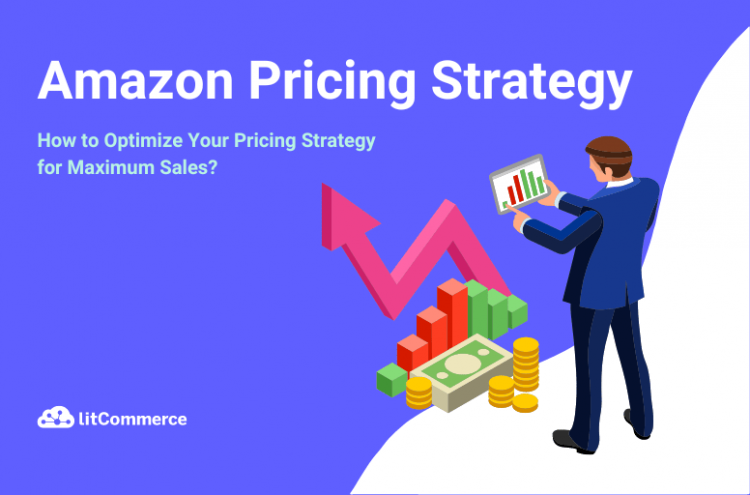Amazon, one of the world’s largest marketplaces, presents an incredible opportunity for sellers to reach millions of potential customers and grow their businesses. However, navigating the platform and standing out among countless competitors can be a daunting task.
In order to increase sales on Amazon, one crucial aspect that sellers must master is Amazon pricing strategy, together with Amazon SEO guide. Understanding and effectively implementing the right pricing strategy can significantly impact a seller’s success on the platform.
In this article, we will discuss key considerations and best practices that can help them thrive in this highly competitive marketplace. We’ll walk you through the following:
- What is Amazon pricing strategy
- How sellers price items on Amazon
- 4 types of Amazon pricing strategies
- How to win the Amazon buy box best practices
What are you waiting for? Let’s dive right in if you want to drive your businesses toward long-term success on Amazon.
What is Amazon Pricing Strategy?
Amazon pricing strategy lies at the core of its success as one of the top global selling platforms. This strategic approach to pricing involves a combination of factors that enable Amazon to attract customers, drive sales, and maintain a competitive advantage. This can be a key factor in helping Amazon surpass other competitors in the market.
In this section, we will walk you through the fundamental elements of Amazon seller pricing strategy. Understanding them will help you gain valuable insights into Amazon price optimization and learn to apply them to your business.
Amazon pricing model
Amazon pricing model is centered around providing the most competitive prices to customers. This model is not fixed and can change multiple times during the day, which is known as Amazon dynamic pricing strategy.
The Buy Box is an integral part of Amazon’s pricing strategy, contributing significantly to its overall success. It serves as a valuable opportunity for sellers to gain visibility and increase sales while simultaneously ensuring that customers are presented with the most competitive prices available. Even if sellers are unable to secure a spot in the Buy Box, they can still achieve high rankings based on a combination of the product price and shipping costs considered by Amazon.

In addition to offering competitive prices, Amazon’s appeal to customers is further strengthened by its exceptional convenience. With a vast array of retailers selling products on the platform, the likelihood of items being out of stock is minimal. This guarantees that consumers can always find the specific products they desire, with various options across different price ranges.
Sellers may wonder: “Does Amazon do price match?” or “Does Amazon price adjustment policy still exist?” This is because these two policies can directly affect how sellers adjust their Amazon strategy for pricing. The answer is “No”, Amazon has discontinued Amazon price match and Amazon price adjustment policy for years. So, sellers can freely set prices for their products without worrying about refunding buyers if they find better deals elsewhere.
How does Amazon pricing work?
Understanding how Amazon pricing works is crucial for sellers when they compete with other sellers on different platforms. If you get confused about Amazon platform and Shopify, check the article about Shopify vs Amazon comparison for an explanation.
Now, let’s get back to how Amazon pricing works with some of the key ways below:
Manual Pricing
Manual pricing involves sellers setting their own prices for products on the Amazon platform. Sellers have the flexibility to determine the initial price, considering factors such as production costs, competitor prices, and desired profit margins. However, manual pricing may require constant monitoring and adjustments to remain competitive and capture customer attention.
Pros:
- Full control over pricing decisions
- Flexibility aligns prices with individual business strategies
- Suit for unique or niche products without direct competitors
Cons:
- Requires continuous monitoring and manual adjustments to remain competitive
- Take time, especially for sellers with a large inventory
- Miss opportunities to optimize prices in real-time
Amazon Repricing Tools
Amazon repricing tools are software solutions specifically designed to automate the process of adjusting Amazon seller pricing. These tools help sellers stay competitive by dynamically repricing their products based on factors such as competitor prices, market demand, and desired profit margins. There are two primary types of repricing tools, namely, rule-based pricing and algorithmic pricing.
Rule-Based Pricing
Rule-based pricing involves setting specific pricing rules or strategies that guide the automatic adjustment of prices. You can set predefined rules, such as minimum and maximum prices, select specific products, and track desired competition. These repricing tools will automatically update your prices. That enables you to optimize your Amazon selling strategy for maximum profitability.
In the market, you can find various repricing tools, both free and paid, providing you with a range of options. Furthermore, Amazon offers its own repricing tool called ‘Automated Pricing’, which is exclusively available to first-party Amazon sellers at no cost.
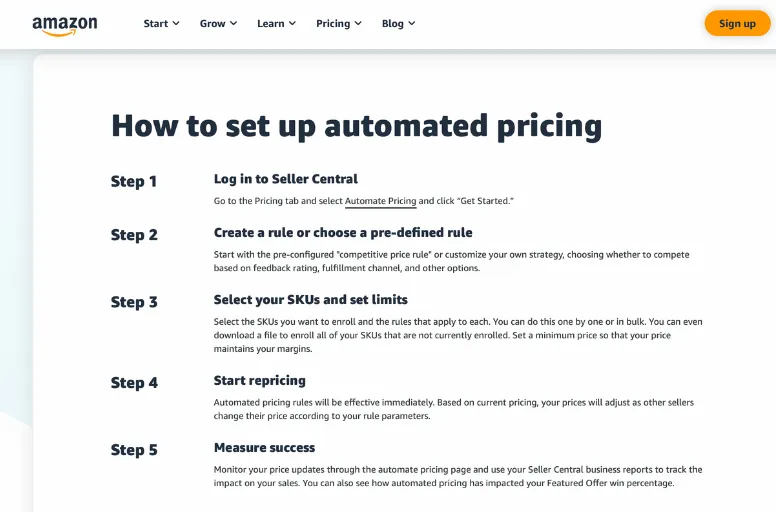
Pros:
- Provides structure and consistency in pricing decisions
- Enables quick adjustments to match or beat competitor prices
- Aligns pricing with specific strategies and objectives
Cons:
- May not capture all pricing nuances when using predetermined rules
- Lacks real-time responsiveness to dynamic market changes.
- Requires careful rule definition and regular evaluation to avoid unintended consequences.
Algorithmic Pricing
Algorithmic pricing goes beyond simple rule-based strategies and utilizes advanced algorithms to determine optimal prices. It operates on an algorithmic basis, considering various metrics to ascertain the optimal price. That ensures the highest return on investment (ROI) for your product.
These algorithms comprehensively evaluate all the necessary factors to secure the buy box, thereby maximizing the seller’s rate of return. Algorithmic pricing allows for real-time optimization and responsiveness to changing market conditions.
Pros:
- Allows for quick and responsive adjustments to changing market conditions.
- Typically more suitable for extensive product inventories
- Offer real-time optimization for price
Cons:
- Initial setup and customization may be complex and time-consuming
- Can be pricey
How Sellers Price Items on Amazon
Effectively pricing items on Amazon is more complex than it appears. While many marketplaces follow a simple logic of raising prices for low sales and lowering prices for high sales, Amazon’s algorithm operates differently. Merely reducing pricing on Amazon to cut margins may not necessarily enhance your position on the platform. Therefore, it is crucial to comprehend the nuances of pricing and various pricing strategies.
There are two primary price types on Amazon that sellers need to understand: the item price and the total price.
The item price refers to the cost of the product itself, excluding shipping costs and other factors affecting the total price that customers see.
The total price or the landed price, encompasses everything included in the final payment made by the customer. This includes:
- Shipping and handling charges
- Discounts, special sales, or promotions
- Other order-related expenses.
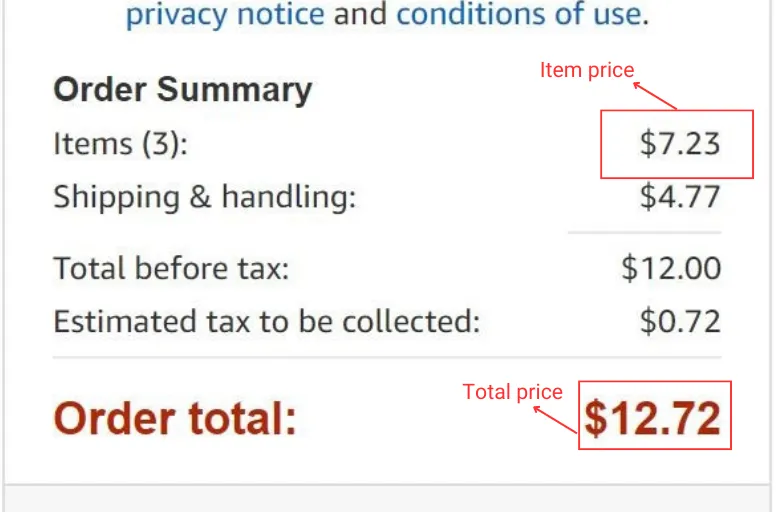
In situations where your product appears in the Other Sellers on Amazon section, and you don’t have the Buy Box, it’s important to note that Amazon considers both the listing product price and the shipping price. While being in the “Other Sellers on Amazon” doesn’t guarantee as much visibility as having the Buy Box, it still provides an opportunity to drive sales. Customers can choose to purchase from one of the sellers listed under this section by clicking on the respective seller’s price.
For ultimate Amazon price optimization, you should carefully consider all the aforementioned elements when repricing your products. Even slight adjustments, such as modifying shipping fees or offering discounts, can significantly impact your product’s Amazon ranking.
4 Types of Amazon Pricing Strategies
There are several pricing strategies that sellers on Amazon can use. Here are four common types of Amazon pricing strategy help them optimize their pricing and increase sales:
1. Economy
The economy pricing strategy on Amazon involves offering products at low prices to target price-sensitive customers. This strategy aims to attract a large customer base by emphasizing affordability. It works by reducing costs and streamlining operations to offer competitive prices. Economy pricing is particularly suitable for customers who prioritize cost savings and are less concerned about premium features or brand reputation. This strategy is commonly employed for essential or everyday items where price plays a significant role in the purchasing decision.
If you aim at selling items in bulk for Business customers, you can also employ the economy strategy for your Amazon business pricing. How much does Amazon Business cost for sellers? This program charges sellers exactly the same as a normal seller account does. But, with a Business account, sellers can negotiate prices with business customers to increase sales volume and profit.
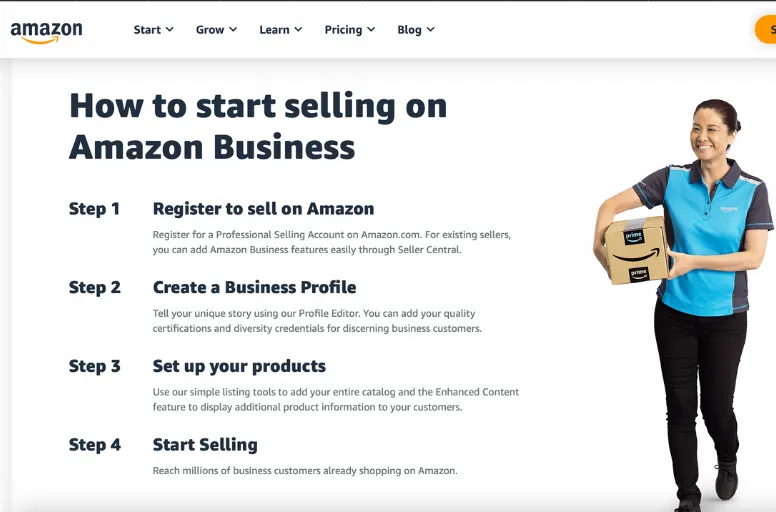
2. Premium
The premium Amazon pricing strategy revolves around setting higher prices for products to position them as premium or high-end offerings. This strategy leverages factors such as superior quality, unique features, brand reputation, or exclusivity to justify the higher prices. Premium pricing targets customers who value luxury, exclusivity and are willing to pay a premium for perceived value. This strategy is most effective for products that offer distinctive features, superior craftsmanship, or align with a luxury brand image.
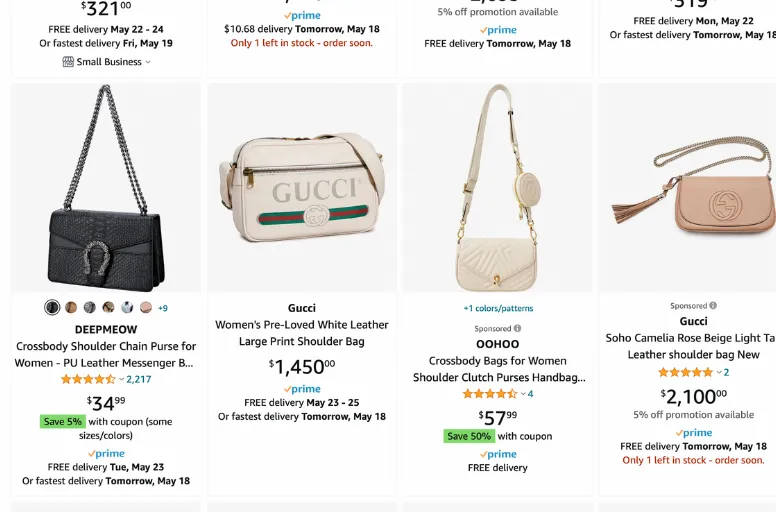
3. Skimming
The skimming pricing strategy involves initially setting high prices for new or innovative products with limited competition. This strategy aims to capitalize on early adopters and customers who are willing to pay a premium for the latest products. Over time, as competition increases or market saturation occurs, the prices are gradually lowered to attract broader customer segments.
Skimming pricing is best suited for products with unique features, technological advancements, or limited availability, where early adopters are willing to pay a premium for exclusivity.
4. Penetration
The penetration Amazon pricing strategy entails setting low initial prices to gain market share and attract customers quickly. This strategy aims to penetrate the market by offering competitive prices, often with the goal of establishing a customer base that can lead to future sales and potential upselling or cross-selling opportunities.
Penetration pricing works well for products entering a competitive market or when a seller aims to capture a significant market share rapidly. It attracts price-conscious customers who are more likely to try new products or switch brands for better deals.
How to Win the Amazon Buy Box Best Practices
If you want to get practical with your Amazon strategy to win the Buy Box, here are some steps you can follow:
1. Analyze your product niche and competitors
Before you set or change your prices, you should do some market research and Amazon pricing strategy analysis based on these factors:
- Which are the best products to sell on Amazon?
- Who are your main competitors?
- What are their prices?
- How often do they change their prices?
- What are their Buy Box percentages?
You can employ some tools like Jungle Scout or Helium 10 to get insights into your product niche and competitors.
2. Determine your profit margin and break-even point
The profit margin differs from your revenue and your cost of selling. It is a financial metric that indicates how much profit is being generated from each sale. The formula for calculating profit margin is:
Profit Margin = (Total Revenue – Total Costs) / Total Revenue x 100
At the same time, the break-even point is the minimum price you need to sell your product to cover your cost of selling.
You should consider these two metrics to ensure you still gain profit while competing with other sellers and winning the Buy Box.
3. Choose the Amazon pricing strategy that suits your goals
Depending on your product niche, your competition, and your goals, you can choose a pricing strategy that works best for you.
We have mentioned 4 main Amazon strategies for your reference above: economy, premium, skimming, and penetration strategies.
- Economy: Best for those looking to attract a larger customer base by offering competitive prices.
- Premium: Best for those who aim to position your brand as high-end.
- Skimming: Best for sellers who want to set higher initial prices for innovative or unique products.
- Penetration: Best for businesses who want to gain market share and attract customers quickly by offering low prices.
4. Additional tips while practicing pricing your items on Amazon:
- Decreasing Price: Lowering the price of a product may lead to increased conversion rates and daily sales. Even small reductions can significantly boost sales. That can result in additional profits from more units sold.
- Increasing price if competitors are out of stock: Increasing the price of a product when your competitive products are unavailable can result in higher daily profits. This strategy may lead to a slight increase in conversion rates. This is because customers are willing to pay for a higher price when you are the only seller having the product in stock.
- Increasing price when inventory is limited: In order to avoid losing their organic rankings on Amazon, some sellers choose to increase prices when their inventory is limited. This strategic approach allows sellers to maintain a steady supply-demand balance on the marketplace and avoid losing visibility and ranking due to frequent stockouts. Additionally, higher prices during limited inventory periods can also generate increased profit margins for sellers.
5. Other ways to win the Buy Box
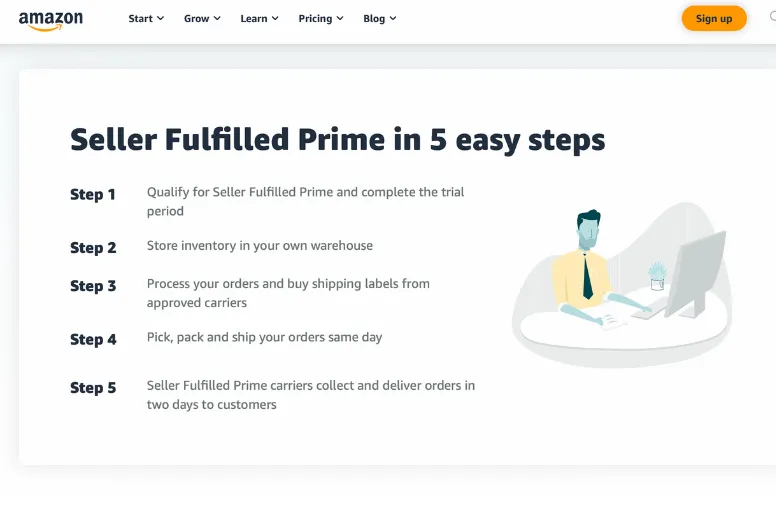
According to the search results, there are several ways to win the Amazon Buy Box besides offering competitive prices. Some of them are:
- Sell products in a new condition
- List as a Prime seller
- Keep strong inventory levels
- Maintain positive seller feedback
- Have a Professional Seller Account
- Offering free, fast, and reliable shipping
- Provide quick and helpful customer support
- Use Fulfillment by Amazon (FBA)
Amazon Pricing Strategy: FAQs
- What is Amazon pricing strategy?
Amazon employs various pricing strategies to determine the prices of products sold on its platform. The pricing strategies used by Amazon are designed to offer customers the best possible prices while also encouraging sellers to remain competitive and maximize their profits.
- Who sets the price on Amazon?
On Amazon, sellers set their own prices for the products they list. However, Amazon may adjust the prices of products sold by third-party sellers through its algorithmic pricing strategy, which takes into account factors like the product category, the seller’s reputation, the seller’s shipping speed, and the prices of similar products from other sellers.
- What type of strategy does Amazon use?
Amazon uses several pricing strategies, including:
- Economy strategy
- Premium strategy
- Skimming strategy
- Penetration strategy
Amazon sellers employ these strategies to determine the prices of their products and optimize sales and profits on the platform. However, sellers do not necessarily use a specific Amazon pricing strategy across all its products and services. The company can use different eCommerce pricing strategy depending on the particular product or service offered.
Conclusion
Amazon pricing strategy is a dynamic and complex process that requires constant monitoring and adjustment. It is influenced by various factors and aims to offer the best value and experience for the customers. By experimenting with different pricing strategies, Amazon sellers can find the optimal solution to help them win the Buy Box.
To learn more about online marketplaces and eCommerce platforms, don’t forget to follow the Retailers Blog. If you have any further concerns, don’t hesitate to reach out to LitCommerce for assistance. We are always happy to provide support and guidance.

